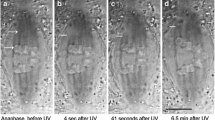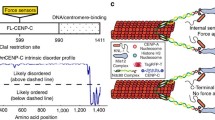Abstract
The relationship of kinetochore orientation and reorientation to orderly chromosome distribution in anaphase has been studied experimentally by micromanipulation of living grasshopper spermatocytes. Bivalents or the X chromosome at prometaphase or metaphase I can be detached from the spindle with a microneedle and moved to any desired location within the cell. Following a pause of variable duration the detached chromosome invariably moved, kinetochores foremost, back to the spindle, reassumed its characteristic metaphase position, and, with one exception, segregated normally at anaphase I. Detachment from the spindle is demonstrated unequivocally (1) by manipulation evidence for the absence of the firm spindle connections seen both before detachment and after reattachment and (2) by a functional criterion: a given kinetochore, oriented to one pole before detachment, often orients to the opposite pole after detachment. The segregation in anaphase was always as expected from the final, post-operation, orientation. Reorientation and prometaphase and anaphase movement after detachment cannot be distinguished from their counterparts in control cells. Kinetochore position after detachment is the primary determinant of the pole to which that kinetochore will orient. Therefore, since the experimenter determines kinetochore position, he can cause any given half-bivalent to segregate to a predetermined pole at anaphase I. Similarly, orientation of both half-bivalents to the same pole can be induced. These mal-oriented bivalents invariably reorient and normal anaphase segregation ensues. Non-disjunction can, however, be produced directly in late anaphase. These experiments are based upon current views of orderly chromosome distribution; their success confirms our understanding of the fundamental orientation process.
Similar content being viewed by others
References
Bauer, H., R. Dietz u. C. Röbbelen: Die Spermatocytenteilung der Tipuliden. III. Das Bewegungsverhalten der Chromosomen in Translokationsheterozygoten von Tipula oleracea. Chromosoma (Berl.) 12, 116–189 (1961).
Behnke, O., and A. Forer: Some aspects of microtubules in spermatocyte meiosis in a crane fly (Nephrotoma suturalis Loew): intranuclear and intrachromosomal microtubules. C. R. Trav. Lab. Carlsberg 35, 431–455 (1966).
Dietz, R.: Die Spermatocytenteilungen der Tipuliden. II. Graphische Analyse der Chromosomenbewegung während der Prometaphase I im Leben, Chromosoma (Berl.) 8, 183–211 (1956); - Multiple Geschlechtschromosomen bei den cypriden Ostracoden, ihre Evolution und ihr Teilungsverhalten. Chromosoma (Berl.) 9, 359–440 (1958); - Centrosomenfreie Spindelpole in Tipuliden-Spermatocyten. Z. Naturforsch. 14b, 749–753 (1959); - Polarisationsmikroskopische Befunde zur chromosomeninduzierten Spindelbildung bei der Tipulide Pales crocata (Nematocera). Zool. Anz. 26 (Suppl.), 131–138 (1963).
Ellis, G.: Piezoelectric micromanipulators. Science 138, 84–91 (1962).
Forer, A.: Local reduction of spindle fiber birefringence in living Nephrotoma suturalis (Loew) spermatocytes induced by ultraviolet microbeam irradiation. J. Cell Biol. 25, Mitosis Suppl., 95–117 (1965).
Hughes-Sohrader, S.: Reproduction in Acroschismus wheeleri (Pierce). J. Morph. 39, 157–205 (1924); - Polarization, kinetochore movements, and bivalent structure in the meiosis of male matids. Biol. Bull. (Woods Hole) 85, 265–300 (1943).
Inoué, S.: Organization and function of the mitotic spindle. In: Primitive motile systems in cell biology, p. 549–594 (R. D. Allen and N. Kamiya, eds.). New York: Academic Press 1964.
—, and A. Bajer: Birefringence in endosperm mitosis. Chromosoma (Berl.) 12, 48–63 (1961).
—, and W. L. Hyde: Studies on depolarization of light at microscope lens surfaces. II. The simultaneous realization of high resolution and high sensitivity with the polarizing microscope. J. biophys. biochem. Cytol. 3, 831–838 (1957).
Lettré, H., et R. Lettré: Le mécanisme de la mitose, discuté a la lumière de l'hypothèse de travail sur la persistance de la fibre fusoriale du chromosome. Coll. intern. Centre nat. Recherche Sci. (Paris) 88, 25–45 (1960).
Lewis, M. R.: Reversible solation of the mitotic spindle of living chick embryo cells studied in vitro. Arch. exp. Zellforsch. 16, 159–166 (1934).
Lima-De-Faria, A.: Recent advances in the study of the kinetochore. Int. Rev. Cytol. 7, 123–157 (1958).
Lorbeer, G.: Die Zytologie der Lebermoose mit Berücksichtigung allgemeiner Chromosomenfragen. Jb. wiss. Bot. 80, 567–817 (1934).
Luykx, P.: Kinetochore-to-pole connections during prometaphase of the meiotic divisions in Urechis eggs. Exp. Cell Res. 39, 658–668 (1965).
Mazia, D.: Mitosis and the physiology of cell division. In: The cell, vol. III, p. 77–412 (J. Brachet and A. E. Mirsky, eds.). New York: Academic Press 1961.
—, and A. M. Zimmermann: SH compounds in mitosis. II. The effect of mecaptoethanol on the structure of the mitotic apparatus in sea urchin eggs. Exp. Cell Res. 15, 138–153 (1958).
Nicklas, R. B.: Recurrent pole-to-pole movements of the sex chromosome during prometaphase I in Melanoplus differentialis spermatocytes. Chromosoma (Berl.) 12, 97–115 (1961); - Chromosome velocity during mitosis as a function of chromosome size and position. J. Cell Biol. 25, Mitosis Supp., 119–135 (1965); - A note on orientation in mitosis and meiosis. J. theor. Biol. 12, 147–150 (1966).
—, and C. A. Staehly: Chromosome micromanipulation I. The mechanics of chromosome attachment to the spindle. Chromosoma (Berl.) 21, 1–16 (1967).
Östergren, G.: Considerations on some elementary features of mitosis. Hereditas (Lund) 36, 1–18 (1950);- The mechanism of co-orientation in bivalents and multivalents. Hereditas (Lund) 37, 85–156 (1951).
Payne, F.: A study of the germ cells of Gryllotalpa borealis and Gryllotalpa vulgaris. J. Morph. 28, 287–327 (1916).
Pease, D. C.: Hydrostatic pressure effects upon the spindle figure and chromosome movement. I. Experiments on the first meiotic division of Urechis eggs. J. Morph. 69, 405–441 (1941); - Hydrostatic pressure effects upon the spindle figure and chromosome movement. II. Experiments on the meiotic divisions of Tradescantia pollen mother cells. Biol. Bull. (Woods Hole) 91, 145–169 (1946).
Resende, F.: Karyokinesis. Port. Acta biol. 2, 1–24 (1947).
Rickards, G. K.: An analysis of co-orientation in mitosis and meiosis. J. theor. Biol. 9, 332–349 (1965).
Schrader, F.: The kinetochore or spindle fiber locus in Amphiuma tridactylum. Biol. Bull. (Woods Hole) 70, 484–498 (1936); - The structure of the kinetochore at meiosis. Chromosoma (Berl.) 1, 230–237 (1939); - Data contributing to an analysis of metaphase mechanics. Chromosoma (Berl.) 3, 22–47 (1947); Mitosis, 2nd ed. New York: Columbia University Press 1953.
Seiler, J.: Geschlechtschromosomenuntersuchungen an Psychiden. I. Experimentelle Beeinflussung der geschlechtsbestimmenden Reifeteilung bei Talaeporia tubulosa (Retz). Arch. Zellforsch. 15, 249–268 (1921).
Went, H. A.: The behavior of centrioles and the structure and formation of the achromatic figure. In: Protoplasmatologica VI/G/1. Wien: Springer 1966.
White, M. J. D.: The evolution of the sex chromosomes. I. The XO and X1X2Y mechanisms in praying mantids. J. Genet. 42, 143–172 (1941); - Cytogenetics of orthopteroid insects. Advanc. Genet. 4, 267–330 (1951).
Author information
Authors and Affiliations
Additional information
Dedicated to Professor Jakob Seiler on the occasion of his eightieth birthday; this is a special pleasure because he was the first to modify the segregation of a particular chromosome.
This investigation was supported in part by research grants GM-8480 and GM-13745 from the Division of General Medical Sciences, United States Public Health Service.
Rights and permissions
About this article
Cite this article
Nicklas, R.B. Chromosome micromanipulation. Chromosoma 21, 17–50 (1967). https://doi.org/10.1007/BF00330545
Received:
Issue Date:
DOI: https://doi.org/10.1007/BF00330545




